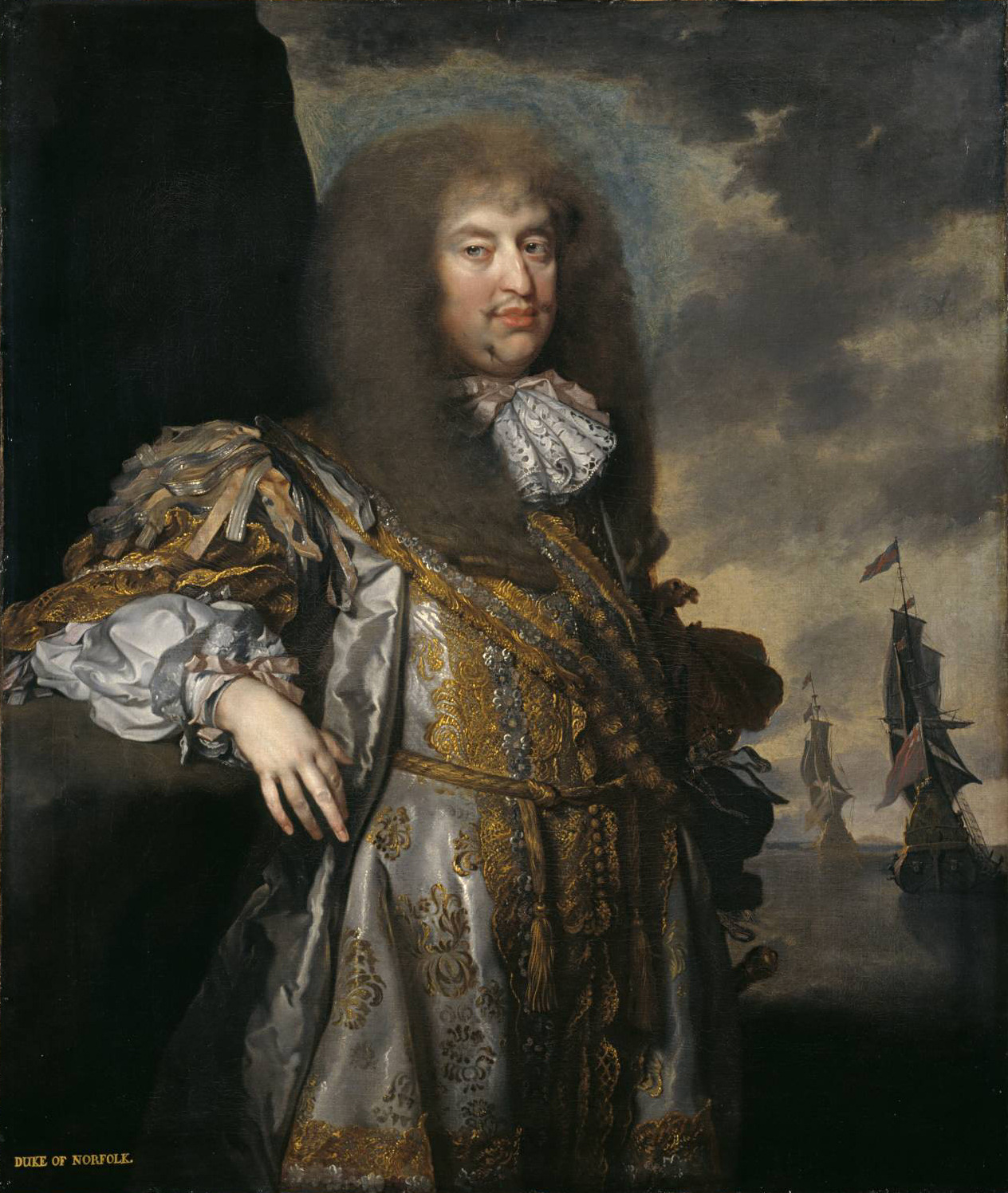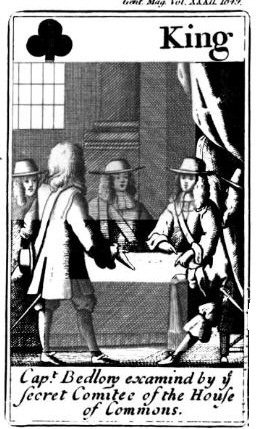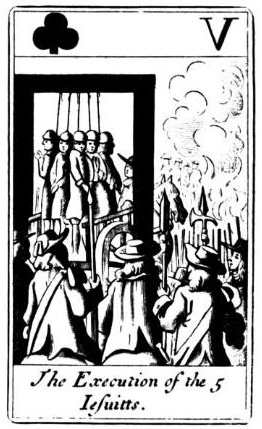|
Henry Howard, 6th Duke Of Norfolk
Henry Howard, 6th Duke of Norfolk (12 July 162813 January 1684) was an English nobleman and politician. He was the second son of Henry Howard, 22nd Earl of Arundel, and Lady Elizabeth Stuart. He succeeded his brother Thomas Howard, 5th Duke of Norfolk after Thomas's death in 1677. Life He had previously been created 1st Baron Howard of Castle Rising in 1669 and 1st Earl of Norwich in 1672, on the latter occasion obtaining the restoration of the office of Earl Marshal of England to him and to his family. There had been near unanimity in the House of Lords in persuading King Charles II to revive the Dukedom of Norfolk in 1660; but since the 5th Duke was insane, and confined to an asylum in Padua, it was felt desirable to summon his brother to the Lords in his own right. His career as Duke began inauspiciously when he announced that he had married Jane Bickerton, who had been his mistress for many years: this caused a violent family quarrel, as a result of which he went abroa ... [...More Info...] [...Related Items...] OR: [Wikipedia] [Google] [Baidu] |
His Grace
His Grace or Her Grace is an English style used for various high-ranking personages. It was the style used to address English monarchs until Henry VIII and the Scottish monarchs up to the Act of Union of 1707, which united the Kingdom of Scotland and the Kingdom of England The Kingdom of England (, ) was a sovereign state on the island of Great Britain from 12 July 927, when it emerged from various Anglo-Saxon kingdoms, until 1 May 1707, when it united with Scotland to form the Kingdom of Great Britain. On .... Today, the style is used when referring to archbishops and non-royal dukes and duchesses in the United Kingdom. Examples of usage include His Grace The Duke of Norfolk; His Grace The Lord Archbishop of Canterbury; or "Your Grace" in spoken or written address. As a style of Dukes in the United Kingdom, British dukes it is an abbreviation of the full formal style "The Most High, Noble and Potent Prince His Grace". Royal dukes, for example Prince Edward, Duke ... [...More Info...] [...Related Items...] OR: [Wikipedia] [Google] [Baidu] |
England
England is a country that is part of the United Kingdom. It shares land borders with Wales to its west and Scotland to its north. The Irish Sea lies northwest and the Celtic Sea to the southwest. It is separated from continental Europe by the North Sea to the east and the English Channel to the south. The country covers five-eighths of the island of Great Britain, which lies in the North Atlantic, and includes over 100 smaller islands, such as the Isles of Scilly and the Isle of Wight. The area now called England was first inhabited by modern humans during the Upper Paleolithic period, but takes its name from the Angles, a Germanic tribe deriving its name from the Anglia peninsula, who settled during the 5th and 6th centuries. England became a unified state in the 10th century and has had a significant cultural and legal impact on the wider world since the Age of Discovery, which began during the 15th century. The English language, the Anglican Church, and Eng ... [...More Info...] [...Related Items...] OR: [Wikipedia] [Google] [Baidu] |
William Bedloe
William Bedloe (20 April 165020 August 1680) was an English fraudster and Popish Plot informer. Life He was born at Chepstow in Monmouthshire. He was probably the son of Isaac Bedloe, himself the son of an Irish Army officer, and a cousin of William Kemys (or Kemish), who became High Sheriff of Monmouthshire in 1678. He appears to have been well educated; he was certainly clever, and after moving to London in 1670 he became acquainted with some Jesuits and was occasionally employed by them. Calling himself now Captain Williams, now Lord Gerard or Lord Newport or Lord Cornwallis, he travelled from one part of Europe to another, usually accompanied by his brother James. In the 1670s he was imprisoned for fraud and became an expert in a number of criminal enterprises. The historian John Kenyon described him as "an experienced member of a London underworld of crime and vice of which we know almost nothing". Then in 1678, following the lead of Titus Oates, he gave an account of a su ... [...More Info...] [...Related Items...] OR: [Wikipedia] [Google] [Baidu] |
Thetford
Thetford is a market town and civil parish in the Breckland District of Norfolk, England. It is on the A11 road between Norwich and London, just east of Thetford Forest. The civil parish, covering an area of , in 2015 had a population of 24,340./ There has been a settlement at Thetford since the Iron Age, and parts of the town predate the Norman Conquest; Thetford Castle was established shortly thereafter. Roger Bigod founded the Cluniac Priory of St Mary in 1104, which became the largest and most important religious institution in Thetford. The town was badly hit by the Dissolution of the Monasteries, including the castle's destruction, but was rebuilt in 1574 when Elizabeth I established a town charter. After World War II, Thetford became an "overspill town", taking people from London, as a result of which its population increased substantially. Thetford railway station is served by the Breckland line and is one of the best surviving pieces of 19th-century railway arc ... [...More Info...] [...Related Items...] OR: [Wikipedia] [Google] [Baidu] |
Recusant
Recusancy (from la, recusare, translation=to refuse) was the state of those who remained loyal to the Catholic Church and refused to attend Church of England services after the English Reformation. The 1558 Recusancy Acts passed in the reign of Elizabeth I, and temporarily repealed in the Interregnum (1649–1660), remained on the statute books until 1888. They imposed punishments such as fines, property confiscation and imprisonment on recusants. The suspension under Oliver Cromwell was mainly intended to give relief to nonconforming Protestants rather than to Catholics, to whom some restrictions applied into the 1920s, through the Act of Settlement 1701, despite the 1828 Catholic Emancipation. In some cases those adhering to Catholicism faced capital punishment, and some English and Welsh Catholics who were executed in the 16th and 17th centuries have been canonised by the Catholic Church as martyrs of the English Reformation. Definition Today, ''recusant'' applies ... [...More Info...] [...Related Items...] OR: [Wikipedia] [Google] [Baidu] |
Oxford University
Oxford () is a city in England. It is the county town and only city of Oxfordshire. In 2020, its population was estimated at 151,584. It is north-west of London, south-east of Birmingham and north-east of Bristol. The city is home to the University of Oxford, the oldest university in the English-speaking world; it has buildings in every style of English architecture since late Anglo-Saxon. Oxford's industries include motor manufacturing, education, publishing, information technology and science. History The history of Oxford in England dates back to its original settlement in the Saxon period. Originally of strategic significance due to its controlling location on the upper reaches of the River Thames at its junction with the River Cherwell, the town grew in national importance during the early Norman period, and in the late 12th century became home to the fledgling University of Oxford. The city was besieged during The Anarchy in 1142. The university rose to domi ... [...More Info...] [...Related Items...] OR: [Wikipedia] [Google] [Baidu] |
Arundelian Marbles
The Arundel marbles are a collection of carved Ancient Greek sculptures and inscriptions collected by Thomas Howard, 21st Earl of Arundel in the early seventeenth century, the first such comprehensive collection of its kind in England. They are now in the Ashmolean Museum, Oxford, having been donated in two groups. History The bulk of the collection was a gift by Arundel's grandson Henry Howard, 6th Duke of Norfolk in 1667, at the prompting of John Evelyn and John Selden. The remainder were received in a second gift of 1755, when the extravagant 2nd Earl of Pomfret sold back to his mother, Henrietta Louisa, Countess of Pomfret, those that had been at his house at Easton Neston and she donated them to the Ashmolean, where they are sometimes called the Pomfret marbles. The Earl of Arundel had supervised excavations in Rome, and deployed his agents in the Eastern Mediterranean, above all at Istanbul. Late in the seventeenth century, a visitor to Ottoman Turkey (in modern-day ... [...More Info...] [...Related Items...] OR: [Wikipedia] [Google] [Baidu] |
Royal Society
The Royal Society, formally The Royal Society of London for Improving Natural Knowledge, is a learned society and the United Kingdom's national academy of sciences. The society fulfils a number of roles: promoting science and its benefits, recognising excellence in science, supporting outstanding science, providing scientific advice for policy, education and public engagement and fostering international and global co-operation. Founded on 28 November 1660, it was granted a royal charter by King Charles II as The Royal Society and is the oldest continuously existing scientific academy in the world. The society is governed by its Council, which is chaired by the Society's President, according to a set of statutes and standing orders. The members of Council and the President are elected from and by its Fellows, the basic members of the society, who are themselves elected by existing Fellows. , there are about 1,700 fellows, allowed to use the postnominal title FRS ( Fellow of ... [...More Info...] [...Related Items...] OR: [Wikipedia] [Google] [Baidu] |
Franciscan
, image = FrancescoCoA PioM.svg , image_size = 200px , caption = A cross, Christ's arm and Saint Francis's arm, a universal symbol of the Franciscans , abbreviation = OFM , predecessor = , merged = , formation = , founder = Francis of Assisi , founding_location = , extinction = , merger = , type = Mendicant Order of Pontifical Right for men , status = , purpose = , headquarters = Via S. Maria Mediatrice 25, 00165 Rome, Italy , location = , coords = , region = , services = , membership = 12,476 members (8,512 priests) as of 2020 , language = , sec_gen = , leader_title = Motto , leader_name = ''Pax et bonum'' ''Peace and llgood'' , leader_title2 = Minister General , leader_name2 = ... [...More Info...] [...Related Items...] OR: [Wikipedia] [Google] [Baidu] |
Bruges
Bruges ( , nl, Brugge ) is the capital and largest city A city is a human settlement of notable size.Goodall, B. (1987) ''The Penguin Dictionary of Human Geography''. London: Penguin.Kuper, A. and Kuper, J., eds (1996) ''The Social Science Encyclopedia''. 2nd edition. London: Routledge. It can be def ... of the Provinces of Belgium, province of West Flanders in the Flemish Region of Belgium, in the northwest of the country, and the sixth-largest city of the country by population. The area of the whole city amounts to more than 13,840 hectares (138.4 km2; 53.44 sq miles), including 1,075 hectares off the coast, at Zeebrugge (from , meaning 'Bruges by the Sea'). The historic city centre is a prominent World Heritage Site of UNESCO. It is oval in shape and about 430 hectares in size. The city's total population is 117,073 (1 January 2008), [...More Info...] [...Related Items...] OR: [Wikipedia] [Google] [Baidu] |
Parliament Of England
The Parliament of England was the legislature of the Kingdom of England from the 13th century until 1707 when it was replaced by the Parliament of Great Britain. Parliament evolved from the great council of bishops and peers that advised the English monarch. Great councils were first called Parliaments during the reign of Henry III (). By this time, the king required Parliament's consent to levy taxation. Originally a unicameral body, a bicameral Parliament emerged when its membership was divided into the House of Lords and House of Commons, which included knights of the shire and burgesses. During Henry IV's time on the throne, the role of Parliament expanded beyond the determination of taxation policy to include the "redress of grievances," which essentially enabled English citizens to petition the body to address complaints in their local towns and counties. By this time, citizens were given the power to vote to elect their representatives—the burgesses—to ... [...More Info...] [...Related Items...] OR: [Wikipedia] [Google] [Baidu] |
Popish Plot
The Popish Plot was a fictitious conspiracy invented by Titus Oates that between 1678 and 1681 gripped the Kingdoms of England and Scotland in anti-Catholic hysteria. Oates alleged that there was an extensive Catholic conspiracy to assassinate Charles II, accusations that led to the executions of at least 22 men and precipitated the Exclusion Bill Crisis. Eventually, Oates's intricate web of accusations fell apart, leading to his arrest and conviction for perjury. Background Development of English anti-Catholicism The fictitious Popish Plot must be understood against the background of the English Reformation and the subsequent development of a strong anti-Catholic sentiment among the mostly Protestant population of England. The English Reformation began in 1533, when King Henry VIII (1509–1547) sought an annulment of his marriage to Catherine of Aragon to marry Anne Boleyn. As the Pope would not grant this, Henry broke away from Rome and took control of the Church i ... [...More Info...] [...Related Items...] OR: [Wikipedia] [Google] [Baidu] |






.jpg)
